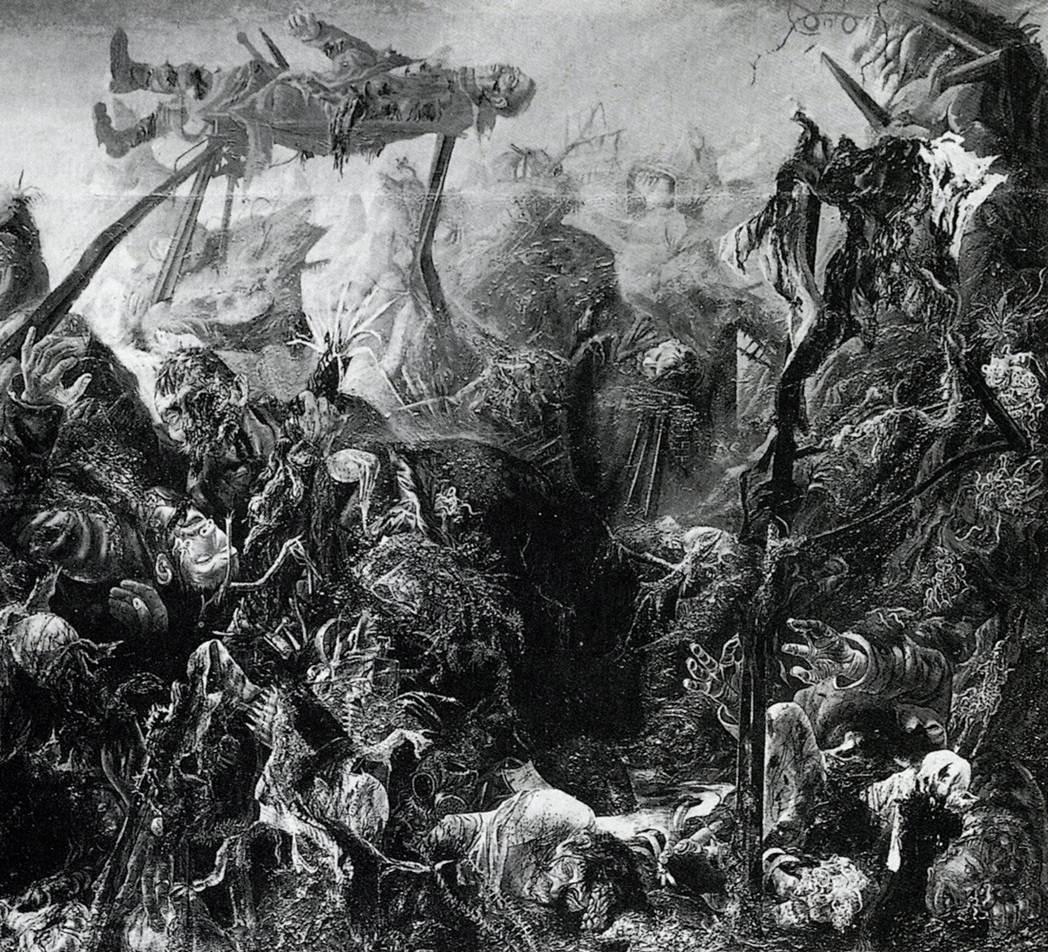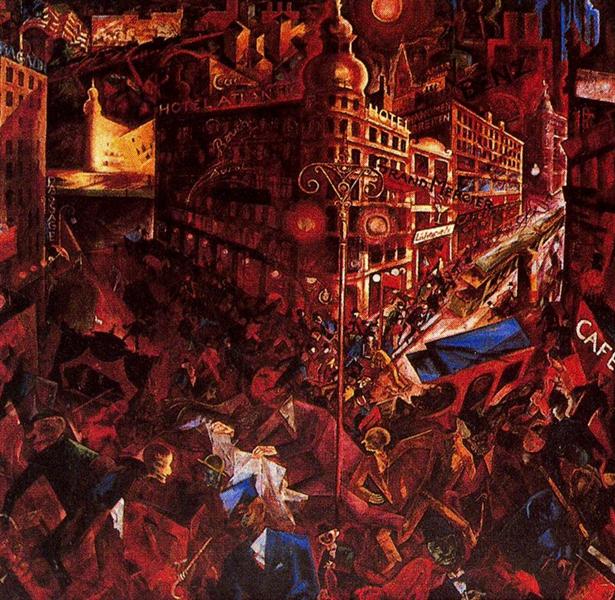The Long View 2007-02-04: Glitter & Doom
This Weimar era art exhibition John J. Reilly describes here sounds fascinating. I found a few examples from the three artists John said were most prominent in the show: Max Beckmann, Otto Dix, and George Grosz.

Max Beckmann – Descent from the Cross 1917
Public domain in the US

Otto Dix – The Trench 1923
Public domain in the US

George Grosz – The City 1916 -1917
Public domain in the US
Their work is fascinating, but I can see why the Weimar era couldn’t hold the hearts of Germans. Much of this art is striking, but very little of it is beautiful.
Glitter & Doom
This is the name of an exhibition, now at the Metropolitan Museum in Manhattan, of paintings and sketches from the Weimar era in Germany. They are portraits, for the most part. The artists were Max Beckmann, Heinrich Maria Davringhausen, Otto Dix, George Grosz, Karl Hubbuch, Ludwig Meidner, Christian Schad, Rudolf Schlichter, Georg Scholz, and Gert H. Wollheim. The emphasis is on Dix, Beckmann, and Grosz, but particularly Dix. I visited the exhibition, which runs for two more weeks, on Saturday, February 3. The website is here.
The show is supposed to be a survey of the Verist tendency of the now venerable Neue Sachlichkeit (New Objectivity) School. Given the general inflation of depravity in high culture in the intervening years, it has been a long time since Weimar was able to shock, but visitors to this exhibition may doubt how shocking its components were even when they were new. A sign at the entrance to gallery warns that some of the pictures may not be suitable for children, and indeed there are a few pictures of prostitutes that would probably merit some blackout bars if the pictures were ever shown on American television. Frankly, though, most of the more tarted-up denizens of the Weimar demimonde seem to be paint-by-numbers illustrations of the theme “Respectability Brought Low.” Beckmann denied any connection with the Verists on the grounds that the school was too literary, and he may have had a point.
Actually, the kids who visit the exhibition are most likely to be scared by the Crypt Keeper intensity of some of the portraits of the artists' friends. Dix in particular was famous for his hallucinogenically unflattering portraits of his patrons, who nevertheless were not a small group. Still, for the most part, these artists were good draftsman: you never get the impression that their departures from reality are due to an inability to represent it. And in fact, the ratio of sentiment and even affection is quite high, especially among the sketches of wives and girl friends.
One perhaps unintended effect of this exhibition is that I will never regard George Grosz's work in quite the same way again. In some ways his pictures of bad, bobble-headed bourgeoisie are as much fun as Disney cartoons, but to see them in the company of other paintings from the same time and place is to realize that they have more to do with George Grosz than with Weimar.
I noted particularly the businessmen. Grosz's are studies in porcine greed. For the other artists, though, the Weimar businessman was a vigorous, young, unsympathetic intelligence, perhaps unsympathetic because the intelligence on their unlined faces is unrelated to experience. And there was this: for the most part, they were shown either holding a telephone, or a telephone was at their elbow. What did the possession of a telephone mean in Germany in the 1920s?
After I left the show, I wandered for a while around the Metropolitan; as usual, I got lost. I don't believe I had seen the garden by the American Art section before. It is one of the finest enclosed spaces in New York. When I got to the Egyptian section, I noticed that visitors were walking on the platform of the Temple of Dendr. I remember that when I walked on that platform many years ago klaxons sounded and guards erupted from every doorway to take me off it. I made up the bit about the klaxons, but apparently the museum management has changed its mind about the fragility of the monument.
I finally had to ask a guard to direct me toward the exit. She sniffed and pointed, apparently offended that anyone would want to leave her wonderful museum.
* * *
Meanwhile, quite without any coordination with me, Spengler at Asia Times has favored us with his own views on modern art:
Admit it - you really hate modern art
You, however, hate and detest the 20th century's entire output in the plastic arts, as do I. ...You have been browbeaten into feigning pleasure at the sight of so-called art that actually makes your skin crawl,...Museums are bulging with visitors who come to view works they secretly detest, and prices paid for modern art keep rising....
An enormous literature exists on the relationship between abstract painting and atonal music, and the extensive Kandinsky-Schoenberg correspondence can be found on the Internet....The most striking difference between the two founding fathers of modernism is this: the price of Kandinsky's smallest work probably exceeds the aggregate royalties paid for the performances of Schoenberg's music. ..
It was the ideologues, namely the critics, who made the reputation of the abstract impressionists...It is not supposed to "please" the senses on first glance, after the manner of a Raphael or an Ingres, but to challenge the viewer to think and consider. ...
When you view an abstract expressionist canvas, time is in your control....When you listen to atonal music, for example Schoenberg, you are stuck in your seat for a quarter of an hour that feels like many hours in a dentist's chair....You are in the position of the fashionably left-wing intellectual of the 1930s who made the mistake of actually moving to Moscow, rather than admiring it at a safe distance. ...By inflicting sufficient ugliness upon us, the modern artists believe, they will wear down our capacity to see beauty.
Again, much 20th-century art is very fine, but Paul Johnson has a point when he suggests that the production of "fashion objects" is a racket. The epilogue of the story of modern art will be the bursting of the investment bubble that has seized on these fashion objects as assets. As is the nature of these things, the collapse could all happen very quickly. Museums and galleries dedicated to this kind of art could become as deserted as Anglican churches, but they are less likely to be turned into mosques: the rooms lack a central focus.
Copyright © 2007 by John J. Reilly
Support the Long View re-posting project by downloading Brave browser. With Both Hands is a verified Brave publisher, you can leave me a tip too!
Comments ()